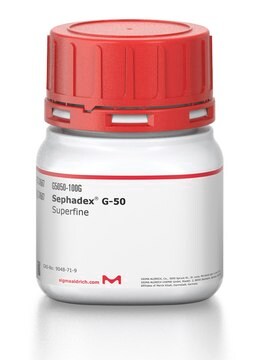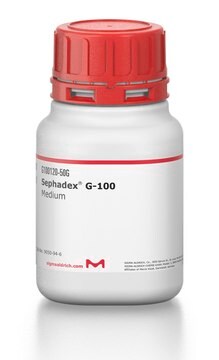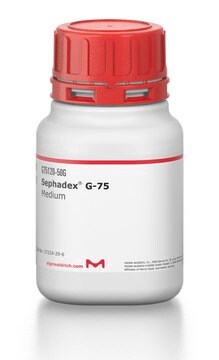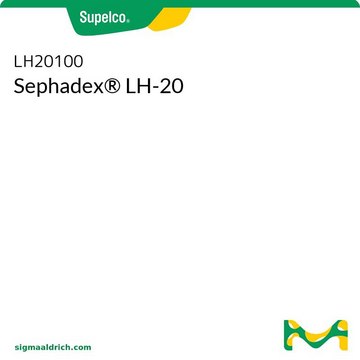S6022
Sephadex® G-50
BioReagent, for molecular biology, DNA grade, medium
Sign Into View Organizational & Contract Pricing
All Photos(2)
About This Item
Recommended Products
grade
DNA grade
for molecular biology
Quality Level
product line
BioReagent
form
beads
swelling
1 g swells to 9-11 mL
bead diameter
50-150 μm
pore size
exclusion limit (20 bp dsDNA; (rA)20)
pH
2-10
foreign activity
DNase, RNase, none detected
storage temp.
room temp
InChI
1S/C18H32O16/c19-1-5(21)9(23)10(24)6(22)3-31-17-16(30)14(28)12(26)8(34-17)4-32-18-15(29)13(27)11(25)7(2-20)33-18/h1,5-18,20-30H,2-4H2
InChI key
FZWBNHMXJMCXLU-UHFFFAOYSA-N
Looking for similar products? Visit Product Comparison Guide
General description
Sephadex® G-50, Medium is an often-cited gel filtration medium for desalting and buffer exchange of biomolecules > 30,000 MW. Sephadex® is prepared by crosslinking dextran with epichlorohydrin. Sephadex products differ in their degree of cross-linking and hence in their degree of swelling and their molecular fractionation range. “Medium” indicates a large particle size for use in large-scale group separations where high flow rates and low operating pressures are required.
Application
Sephadex® G-50 is suitable for spin column purification of DNA (from contaminating small molecules) for use in hybridizations. It was used to purify PCR products prior to DNA sequencing reactions.
Sephadex® G-50 has been used to purify the DNA products in cycle sequencing reactions.
Features and Benefits
- Excellent recovery
- Minimal sample dilution
- Quick and easy to use
Legal Information
Sephadex is a registered trademark of Cytiva
related product
Product No.
Description
Pricing
Storage Class Code
11 - Combustible Solids
WGK
WGK 3
Flash Point(F)
Not applicable
Flash Point(C)
Not applicable
Personal Protective Equipment
dust mask type N95 (US), Eyeshields, Gloves
Choose from one of the most recent versions:
Already Own This Product?
Find documentation for the products that you have recently purchased in the Document Library.
R Symula et al.
Molecular phylogenetics and evolution, 47(2), 569-580 (2008-03-20)
Geographic patterns of species diversity in southeast Australia have been attributed to changes in Pleistocene climate, but related phylogeographic patterns and processes are relatively understudied. 12S and 16S mitochondrial DNA sequences in Crinia signifera populations were used to infer historical
Alisha K Holloway et al.
The American naturalist, 167(4), E88-101 (2006-05-04)
Polyploidization is one of the few mechanisms that can produce instantaneous speciation. Multiple origins of tetraploid lineages from the same two diploid progenitors are common, but here we report the first known instance of a single tetraploid species that originated
The history of a Nearctic colonization: molecular phylogenetics and biogeography of the Nearctic toads (Bufo)
Pauly GB, et al.
Evolution, 58(11), 2517-2535 (2004)
Mark Del Campo et al.
Journal of molecular biology, 389(4), 674-693 (2009-04-28)
The DEAD-box proteins CYT-19 in Neurospora crassa and Mss116p in Saccharomyces cerevisiae are broadly acting RNA chaperones that function in mitochondria to stimulate group I and group II intron splicing and to activate mRNA translation. Previous studies showed that the
Katharina Besemer et al.
Applied and environmental microbiology, 75(22), 7189-7195 (2009-09-22)
Streams are highly heterogeneous ecosystems, in terms of both geomorphology and hydrodynamics. While flow is recognized to shape the physical architecture of benthic biofilms, we do not yet understand what drives community assembly and biodiversity of benthic biofilms in the
Our team of scientists has experience in all areas of research including Life Science, Material Science, Chemical Synthesis, Chromatography, Analytical and many others.
Contact Technical Service








